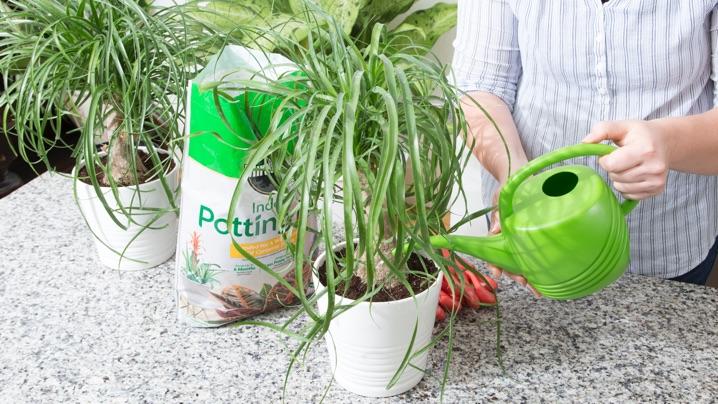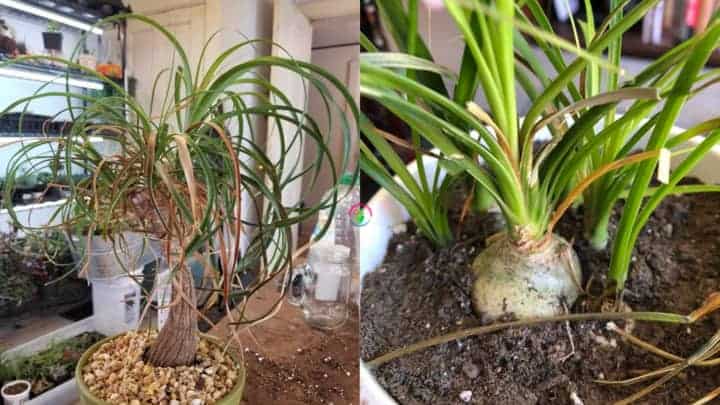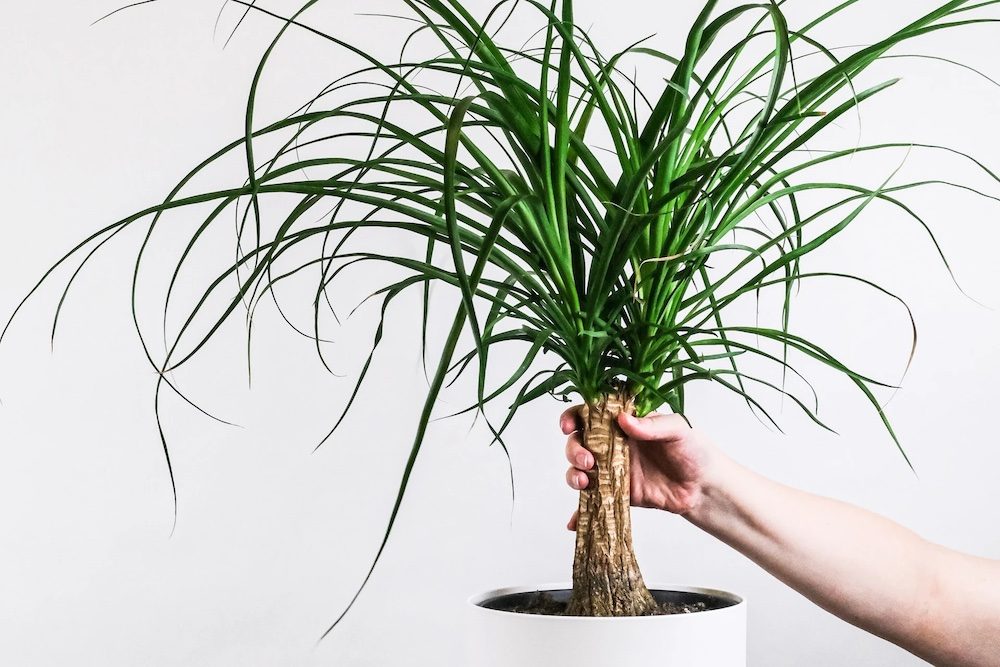- No products in the cart.
Although the Ponytail Palm (Beaucarnea recurvata) doesn’t require frequent watering, it may develop dry brown tips. If you’re experiencing this issue, follow these steps to revive your dried-out Ponytail Palm and witness its speedy recovery. Read this article to discover more about Ponytail Palm Brown Tips.

Ponytail Palm Brown Leaves
The Ponytail Palm is an attractive houseplant that’s easy to care for, but it’s prone to developing brown tips on its leaves. If you’re seeking a solution to this issue, don’t worry, as we’re here to assist you. Before we delve into fixing the problem, let’s explore some interesting facts about the Ponytail Palm.
Did you know that the Ponytail Palm isn’t a palm tree at all? Despite its name, this plant is a succulent that features a single trunk and long, thin, grass-like leaves that resemble a palm. Because of its succulent nature, it’s easy to propagate and can even regrow its top.
When grown indoors in pots, Ponytail Palms can reach up to four feet in height. However, if they’re grown outdoors without any restrictions, they can grow up to thirty feet tall. These plants are indigenous to eastern Mexico and thrive in a hot and dry environment.
This information is beneficial to know if you’re a Ponytail Palm owner as it provides insight into the plant’s preferred surroundings. As a desert plant, Ponytail Palms are quite resilient and require minimal watering to maintain their health.
Ponytail Palm Brown Tips refer to the browning of the tips of the leaves of the Ponytail Palm plant. It is a common issue that occurs with this plant and can be caused by various factors, such as overwatering, underwatering, exposure to cold or hot temperatures, and lack of proper nutrients. It’s essential to address the problem promptly and take appropriate measures to revive the plant’s health.
Why Does My Ponytail Palm Leaves Turning Brown?
The occurrence of brown tips is a prevalent issue faced by Ponytail Palms, but the cause of the problem may not always be apparent. Brown tips can arise due to a single factor or a combination of factors, and finding a solution may require some investigation. Let’s take a look at some of the common causes of brown tips in Ponytail Palms.
Overwatering
The ponytail palm is a plant native to the arid and hot region of eastern Mexico, where it has evolved to thrive in tough conditions. However, these same traits that help it survive in the wild can cause problems when the plant is kept as a houseplant, with the most common issue being brown leaf tips caused by overwatering.

The ponytail palm relies on a strong root system to absorb and store water in the desert, but when it receives too much water, the roots become oversaturated and lead to browning of the leaves, soft and mushy trunk, and root rot.
To prevent these problems and maintain a healthy plant, it’s essential to follow specific guidelines when watering your ponytail palm. Factors such as the amount of light it receives, the size of the plant, and the soil consistency and mixture will determine how much water the plant needs.
You should also consider room temperature, pot size, and fertilization frequency to ensure optimal growth. By following these guidelines, you can help your ponytail palm thrive and avoid brown leaf tips and other common issues.
Underwatering
On the contrary, brown tips on ponytail palms can result from underwatering. While this plant can endure periods of drought, it also has its limits.
When a ponytail palm goes without water for too long, it will become stressed and its leaf tips will begin to turn brown and wither. Although this affects the plant’s appearance, it is a survival mechanism. The ponytail palm prioritizes keeping the central tissues of the plant hydrated, sacrificing the leaf tips.

You can easily spot underwatering when the soil feels as dry as dust, the pot feels light, and the soil is dry from bottom to top.
To remedy this, water your ponytail palm thoroughly, completely saturating the soil. You can take the plant to the sink and water it from the top, letting the sink partly fill with water for a few minutes to give the plant extra time to absorb the water. But be sure to drain the plant well after a few minutes. Don’t try to compensate for underwatering by overwatering. Just resume a normal watering routine, checking the plant and soil every few days and waiting until the top 2-3 inches of soil has dried before adding more water.
Not enough light
The ponytail palm requires a lot of light and thrives when exposed to it for extended periods. To ensure its growth, it’s important to place it in a well-lit area. While you don’t need to obsess over every leaf receiving enough light, maximizing the amount of light the plant receives is crucial.
During winter months, the light may not be as consistent, but the ponytail palm is still able to survive thanks to its hardiness. Some people choose to keep their ponytail palm outside during the summer to store extra energy from the light for use during the winter. While this can be beneficial, it is not essential for the plant’s survival.
Occasionally, overexposure to sunlight can result in the ponytail palm developing brown tips, but this is typically due to a combination of excessive light and lack of water over an extended period. It would take neglecting to water your plant for several months before this effect becomes visible.
Problems with Soil and Potting
To prevent brown leaf tips and promote healthy growth, a recommended soil mixture for the ponytail palm is a blend of perlite, sand, and standard potting soil. Equal parts of each should be used in a pot until there is only a small gap at the top and edges. It’s also essential to have drainage holes at the bottom of the pot to allow excess water to drain away effectively.
It is important to keep the trunk of the ponytail palm above the soil line to prevent rotting. The size of the pot should be selected based on the size of the plant and the temperature of the room, which should ideally between 60° and 80°F.
Finally, ddding fertilizer is not necessary, but a small amount in the spring and once in the summer can help revive an undernourished ponytail palm. However, be careful not to over-fertilize as this can result in brown leaf tips. Only use a quarter of the recommended amount and apply sparingly.
Proper Care is Essential to Prevent Ponytail Palm Brown Tips
By following these guidelines, you can prevent overwatering and maintain the green color of your ponytail palm’s leaf tips. It’s essential to take each of the above-mentioned factors seriously as they directly influence the watering process and its consequences.
To prevent brown leaf tips on your ponytail palm, it’s important to follow watering guidelines. The plant prefers drier soil, so only water it once the top 2-3 inches of soil has dried out. The exact timing will depend on the plant and its environment, but this is a good rule of thumb to follow. It’s crucial not to overwater, as this can cause root rot and browning of the leaves.

To water your ponytail palm, fully saturate the soil with room temperature water and let it drain through the bottom of the pot for several minutes. It’s essential to let the plant sit in the water collected in the drip tray, but no longer than five to ten minutes.
Afterwards, take out the drip pan and discard any excess water. Also, be careful not to splash too much water onto the trunk as it can lead to rotting. The next time you water your ponytail palm will be in about two to three weeks, or when the top two to three inches of soil has completely dried out.
Relying solely on visual inspection to determine the dryness of the soil is not sufficient as you cannot ascertain the moisture content below the surface. For accuracy, insert your finger into the top few inches of the soil to confirm that it is completely dry and the plant requires watering.
Preventing Brown Tips on Ponytail Palms from Overwatering
If you suspect that your ponytail palm’s leaves have turned brown due to overwatering, there are certain signs that you can look out for to confirm your suspicion.
Initially, before the tips of the plant start to turn brown, you may observe some other changes in the foliage such as wilting, yellowing, and even shedding of leaves. On examining the soil, if you find that the roots have turned brown instead of their natural white color, it is likely that the plant has developed root rot.
Continuing to water the plant in such a condition will further worsen the root rot. But if the rotten parts are removed and the roots are allowed to dry out, they may regenerate, and the plant can recover.

If you suspect that your ponytail palm is overwatered, you should stop watering it immediately and let it dry out completely. Overwatering can cause the stem to rot, which can block the movement of nutrients through the plant. Allowing the plant to dry out can help it recover without the need for extra fertilizers, but it’s important to catch the damage early to increase the chances of recovery.
When ponytail plants are overwatered, their leaves may turn yellow and brown due to insufficient chlorophyll, which is necessary for energy production required for blooming. Even if you correct the watering problem, it may take a year or more for the plant to recover enough to produce a healthy bloom.
Summary
In conclusion, proper care of your ponytail palm, including avoiding overwatering, ensuring adequate drainage, and providing appropriate lighting and fertilization, can prevent brown tips and promote a healthy and vibrant plant.
Read more:

